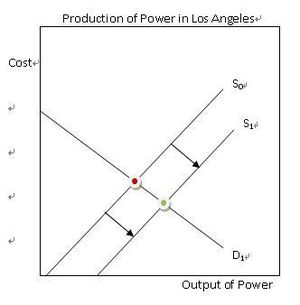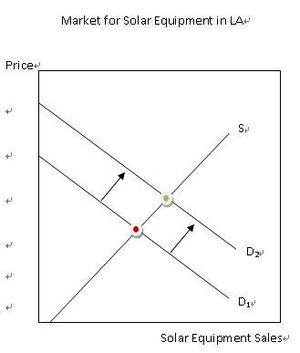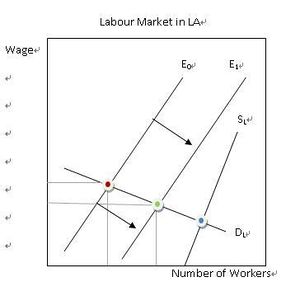Course:ECON371/UBCO2009WT1/GROUP5/Article3
World’s Most Ambitious Solar Plan in LA
Article
http://www.alternative-energy-news.info/ambitious-solar-plan-la/
Summary
The article states that in order to replace the fossil fuels during peak energy requirement, the city of Los Angles is taking up the world’s most ambitious solar power project, which is called Solar LA, the largest solar power plan in the world so far, it lays out a far-reaching and long-lasting course of action for a network of residential, commercial and municipally-owned solar systems. Boosting residential and commercial customer solar systems, owning solar projects in Los Angeles by LADWP, and owning the large scale solar projects by LADWP outside of the LA basin are the three primary components of the Solar LA plan. LADWP will also utilize $313 million in state funds to expand its rebate by encouraging customers to install solar panels for their power needs, or by providing free system to low-income group customers. Varied types of jobs can be created by investing in green power, therefore Los Angles would be giving the necessary push to “cleantech” economy. LA will generate a tenth of Los Angeles’ power through solar energy by 2020 if Solar LA plan is finished. By then, Los Angeles becomes a world leader in the solar industry and a cleanest, greenest city in America.
Analysis
Production of Power in Los Angeles
Part of the program includes building solar projects on the buildings that the LADWP already own around LA. They also intend to create large projects outside of LA and will license power from other developers outside of LA. Although the solar production of power includes more expensive start up costs, once in place it will be effective to increase supply of power around LA. This will move the supply curve from S0 to S1 letting LA meet more demand at their new green equilibrium point. This will also lower cost of production on the whole.
Market for Solar Equipment in LA
The Solar LA program plans to encourage the use of solar power in a few ways. It will expand current rebate programs that encourage customers to install solar panels. They will provide free systems to a limited number of low-income people. Also, they encourage low interest loans to go to residential customers for the installation of solar panels. These actions are expected to increase demand in the private sector sales of solar equipment from curve D1 to D2 and from the red equilibrium point, to the green. This is important because many manufacturers of these goods are from California and it will help to stimulate their beaten economy.
Market for Power on the Public Grid
These same actions have a very important reverse effect on the use of power on the public grid. Putting a number of large commercial and residential users on their own private power source will lower the demand for power from the public grid. This is important for the LADWP because it will help them to continue to avoid the blackouts that plague other parts of California. This will move the demand curve from D1 to D2 and equilibrium from the red point to the green point. This new equilibrium shows a more controlled demand as well as lower price.
Labour Market in LA
The most important part of this initiative by LA is to create jobs for their beaten economy. A release from the mayor’s office stated that every 10 MW of solar energy produced would create 200-400 jobs for the area. This would move the employment curve from E1 to E2, slightly lowering wage but increasing employment. Equilibrium would go from the red point to the green point, getting closer to the blue point which is the efficient equilibrium where the supply of labour meets the demand.
Prof's Comments
The initiative is a public expenditure to increase solar power. In the context of our course, how is this a response to an externality problem? Solar power has a smaller climate change impact. Thus, if we consider a market for solar power and one for conventional power, the external cost in the solar power market is lower. The subsidies shift out the supply in the solar power market, reducing the price of solar electricity. For power suppliers, it reduces their cost and makes them competitive with conventional power.
The issue of employment must be considered carefully. Is unemployment high enough in California that this project will put a lot of people to work, or will the people doing the work be taken from other jobs? If the latter, then the employment benefit, while important to the political discussions, is not a real benefit.



